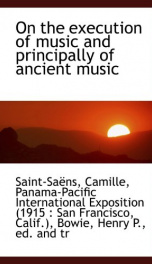on the execution of music and principally of ancient music

an excerpt from the beginning: MUSIC was written in a scrawl impossible to decipher up to the thirteenth century, when Plain Song (Plain Chant) made its appearance in square and diamond-shaped notes. The graduals and introits had not yet been reduced to bars, but the songs of the troubadours appear to have been in bars of three beats with the accent on the feeble note of each bar. However, the theory that this bar of three beats or triple time was used exclusively is probably erroneous. St. Isidore, in his treatise on music, speaking of how Plain Song should be interpreted, considers in turn all the voices and recommends those which are high, sweet and clear, for the execution of vocal sounds, introits, graduals, offertories, etc. This is exactly contrary to what we now do, since in place of utilizing these light tenor voices for Plain Song, we have recourse to voices both heavy and low. In the last century when it was desired to restore Plain Song to its primitive purity, one met with insurmountable obstacles due to its prodigious prolixity of long series of notes, repeating indefinitely the same musical forms; but in considering this in the light of explanations given by St. Isidore, and in view of the Oriental origin of the Christian religion, we are led to infer that these long series of notes were chants or vocalizations analogous to the songs of the Muezzins of the Orient. At the beginning of the sixteenth century musical laws began to be elaborated without, however, in this evolution towards modern tonal art, departing entirely from all influence of the antique methods. The school named after Palestrina employed as yet only the triads or perfect chords; this prevented absolutely all expression, although some traces of it appear in the "Stabat Mater" of that composer. This music, ecclesiastical in character, in which it would have been chimerical to try to introduce modern expression, flourished in France, in Flanders, in Spain at the same time as in Italy, and enjoyed the favor of Pope Marcellus, who recognized the merit of Palestrina in breaking loose from the grievous practice of adapting popular songs to church music. In the middle ages, as in antiquity, the laws of harmony were unknown; when it was desired to sing in two parts, they sang at first in intervals of fifths and fourths, where it would have seemed much more natural to sing in thirds and sixths. Such first attempts at music in several parts were made in the thirteenth, fourteenth and fifteenth centuries, when they were hunting for laws, and such music was discordant. It bore the name of Diaphony. The real Polyphony came in the sixteenth century with the school of Palestrina. --This text refers to the Kindle Edition edition.
Info about the book
Author:
Series:
Unknown
ASIN:
125000764X
Rating:
4.5/5 (4)Your rating:
0/5
Languge:
English
Users who have this book
Users who want this book
What readers are saying
What do you think? Write your own comment on this book!
write a commentif you like on the execution of music and principally of ancient music try:
Other books by this author
Do you want to read a book that interests you? It’s EASY!
Create an account and send a request for reading to other users on the Webpage of the book!


